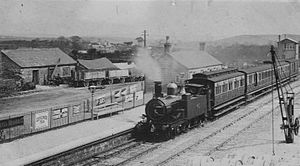GWR 455 Class
| GWR 455 Class | |||||||||||||||||
|---|---|---|---|---|---|---|---|---|---|---|---|---|---|---|---|---|---|

GWR 455 Class at Bugle in Cornwall, around 1910
|
|||||||||||||||||
|
|||||||||||||||||
|
|||||||||||||||||
|
|||||||||||||||||
| Type and origin | |
|---|---|
| Power type | Steam |
| Designer | Joseph Armstrong |
| Builder | GWR Swindon works |
| Build date | 1868-1899 |
| Total produced | 140 |
| Specifications | |
|---|---|
| Configuration: |
|
| • Whyte | 2-4-0T |
| Gauge | 4 ft 8 1⁄2 in (1,435 mm) standard gauge |
| Driver dia. | 5 ft 0 in (1.524 m) |
| Fuel type | Coal |
| Cylinders | two |
| Cylinder size | 16 in × 24 in (406 mm × 610 mm) |
| Career | |
|---|---|
| Operators | GWR |
| Withdrawn | 1900 - 1949 |
| Disposition | All scrapped |
The GWR 455 Class, also called the "Metropolitan" or "Metro" Tanks, was a series of 140 2-4-0 tank locomotives built for the Great Western Railway, originally for their London suburban services, including running on the underground section of the Metropolitan Railway, the source of their nickname. Later on the class was seen on many other parts of the GWR system. Sixty "Metro" Tanks were built, from 1868 onwards, during the lifetime of their designer, Joseph Armstrong. His successor William Dean regarded the class so highly that he would add a further 80, the final 20 examples appearing as late as 1899. The "Metros" were all built at Swindon Works, in nine lots of ten or 20 engines each.
They were numbered as followed:
Nos. 3-6 were briefly numbered 1096-1099 when new, and No. 3500 was numbered 3600 until December 1912. No. 3593 was rebuilt as a 2-4-2T in 1905.
The first two batches had inside frames on all axles, but subsequently the leading wheels had outside axleboxes. The original 20 engines had a shorter coupled wheelbase than all the others, 8'0" rather than 8'3". Nos. 455-470 were partially rebuilt with longer wheelbases when first reboilered, in the 1880s, though not between the coupled wheels. Many of the earlier engines were rebuilt with larger tanks when reboilered, while the locomotives built in 1899 had still larger side tanks and coal bunkers when new; Nos. 1401-1410 were likewise rebuilt with larger tanks about the same time. Because of all these variations, the class is said to have existed in Small, Medium and Larger varieties. They all had driving wheels of 5'0" diameter (later sometimes enlarged by the use of thicker tyres to 5'2") and 16" x 24" cylinders.
The earlier locomotives also differed from each other as to the boilers fitted. None of the originals had cabs - Armstrong always considered that these had a bad effect on the crew's attentiveness - but both half and full cabs were added later, and were provided from new on the later batches. A proportion of the class was intended to be fitted with condensing apparatus, for service on the Metropolitan: Nos. 613-622, 967-976, 1401-1410, and the engines of the last three batches. However, photographs show that some engines in the series did not in fact carry the apparatus. In their later years, from 1905, some of the class was fitted with autotrain apparatus for push-pull working.
...
Wikipedia
